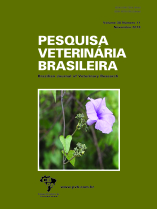 |
|
|
|
Year 2018 - Volume 38, Number 11
|

|
Subplacental development in Galea spixii, 38(11):2175-2182
|
ABSTRACT.- Bezerra F.V.F., Favaron P.O., Mess A.M., Araújo Júnior H.N., Oliveira G.B., Pereira A.F., Miglino M.A. & Oliveira M.F. 2018. Subplacental development in Galea spixii. [Desenvolvimento subplacentário do preá (Galea spixii).] Pesquisa Veterinária Brasileira 38(11):2175-2182. Universidade Federal Rural do Semi-Árido, Av. Costa e Silva s/n, Mossoró, RN 59625-900, Brazil. E-mail: ferdinando_vinicios@hotmail.com
Animal models are essential to understand healthy human placentation. Guinea pig related rodents became on focus for such purposes. In particular, processes of trophoblast invasion are similar. The latter is associated with a specialized area, the subplacenta. Since previous results showed differences between the guinea pig and its close relative Galea spixii, we aimed to study subplacental development with more detail. We investigated 16 pregnant females of 14 to 55 days of gestation by means of histology, morphometrics, immunohistochemistry and electron microscopy. The overlap between the fetomaternal blood systems resulted as intimate, suggesting some exchange processes. Proliferation was revealed by three independent methods, being most active in early and mid-gestation, which was in accordance to former results. Though degeneration of tissues took place, the subplacenta was maintained towards term with access to the fetal vascularization, supporting a hypothesis about the release of substances to the fetal unit in advanced gestation. In contrast to other species, the extraplacental trophoblast showed a shift from syncytial streamers to giant cells during mid-gestation. Views on placentation in caviomorphs were influenced by the guinea pig, but our data supported recent studies that the subplacenta had a much greater placidity. In regard to subplacental grow, degeneration and likely also exchange processes, Galea and other species showed a more basal pattern of caviomorphs than the guinea pig. Such differences should be considered, when choosing most adequate animal models for special purposes in comparison to human placentation. |
| |
|
|
| |
|
 |